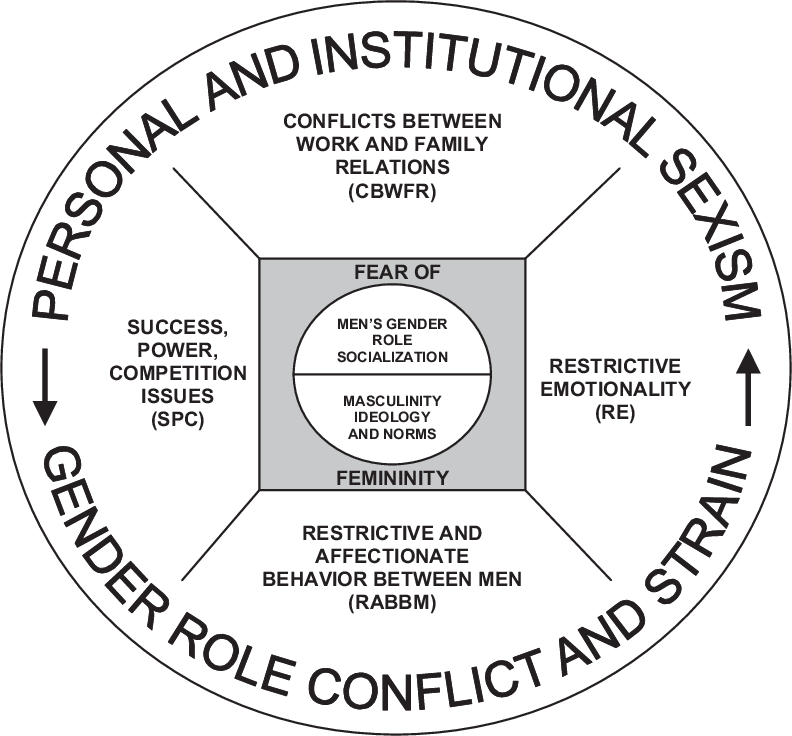Men & Masculinities 101: Gender Role Conflict
The fourth inclusion in our new monthly series: Men & Masculinities 101. These brief posts are designed to provide an overview of a variety of entry-level topics in the field of men and masculinities.
Gender role conflict (GRC) refers to the psychological circumstances in which socially prescribed gender roles contribute to personal restrictions, devaluation, or violation of either one’s own self or others around them (O’Neil et al., 1986). Whereas traditional masculine ideology (TMI) describes individuals’ beliefs about the rigid, stereotyped characteristics and behaviors that define what it means to be “a man,” GRC represents the direct consequence of rigid adherence to these beliefs. Said another way, if TMI is conceptualized as a rigid box in which masculine or manly traits are both rigidly defined and restricted, then GRC describes situations in which men are bound to that box, even when stepping out of the box would be more adaptive or beneficial (or moreover, when staying in the box would be harmful).
For example, because men are often socialized to be stoic or limited in their emotional expression (i.e., “real men don’t cry”), rigidly adhering to this ideology and consistently “bottling up” one’s feelings, especially in instances where the individual would benefit from confiding in another, may over time lead to personal and relational problems. It is important to note that while many men are able to manage these gendered expectations healthily, and step in and out of the box as needed, some men find these prescribed gender roles more restrictive than others, and thus adhere to them more rigidly. It is in these instances that GRC often arises and contributes to a wide range of psychological and interpersonal problems (O’Neil, 2012).
Four distinct patterns of GRC have been empirically derived and are captured in the widely used Gender Role Conflict Scale (GRCS; O’Neil et al., 1986), as well as the short form of the GRCS (Wester et al., 2012). These include 1) Success, Power, and Competition; 2) Restricted Emotionality; 3) Restricted Affectionate Behavior Between Men; and 4) Conflict Between Work and Family Relationships. Each pattern refers to different situational domains in which GRC commonly occurs. Likewise, the problems associated with GRC occur at four overlapping levels (O’Neil et al., 2017). GRC can manifest cognitively, whereby individuals cognitively appraise their perceived adherence to gendered norms. GRC is also related to affect, as men differ in the degree to which they feel comfort or conflict associated with their performance of their gender, adherence to traditional gender roles, and their gender role identities. Thirdly, GRC has behavioral aspects, which include how men perform their gender as well as how they treat themselves or others when gendered norms are violated. Finally, GRC can also operate on an unconscious level, where the thoughts, feelings, or behaviors elicited from GRCs fall outside individuals’ conscious awareness.
Conceptual Diagram of Gender role Conflict from, O’Neil, J. M. (2015). Men’s gender role conflict: Psychological costs, consequences, and an agenda for change. American Psychological Association.
Personal experiences of GRC can be further broken down into three distinct forms: devaluations, restrictions, and violations (O’Neil et al., 2017). Devaluations describe criticisms of one’s own or other’s adherence to gender role norms and expectations that can result in the reduction of an individual’s self-worth, the value of a particular behavior or trait, or both (i.e., men publicly demonstrating emotions or the role of the full-time father/stay-at-home dad). Restrictions describe the restrictive nature of the experience of gender role conflict, which works to confine individuals to the rigid adherence of traditional gender roles. Finally, violations represent the most severe form GRC, in which men harm themselves, harm others, or experience harm from others as a result of gender role socialization.
References
O’Neil, J. M. (2015). Men’s gender role conflict: Psychological costs, consequences, and an agenda for change. American Psychological Association
O’Neil, J. M. (2012). The psychology of men. In E. M. Altmaier & J. C. Hansen (Eds.), The Oxford handbook of counseling psychology (pp. 375–408). Oxford University Press.
O'Neil, J. M., Helms, B. J., Gable, R. K., David, L., & Wrightsman, L. S. (1986). Gender-role conflict scale: College men's fear of femininity. Sex Roles, 14, 335-350. https://doi.org/10.1007/BF00287583
O’Neil, J. M., Wester, S. R., Heesacker, M., Snowden, S. J. (2017). Masculinity as a heuristic: Gender role conflict theory, superorganisms, and system-level thinking. In R. F. Levant & Y. J. Wong (Eds.), The psychology of men and masculinities (pp. 75-103). American Psychological Association.
Wester, S. R., Vogel, D. L., O'Neil, J. M., & Danforth, L. (2012). Development and evaluation of the Gender Role Conflict Scale Short Form (GRCS-SF). Psychology of Men & Masculinity, 13(2), 199–210. https://doi.org/10.1037/a0025550


